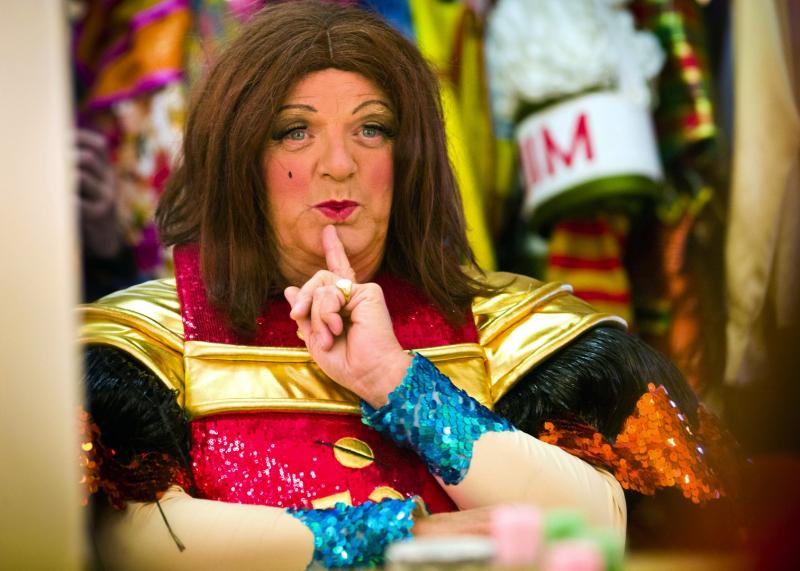Michael Grade's History of the Pantomime Dame, BBC Four | reviews, news & interviews
Michael Grade's History of the Pantomime Dame, BBC Four
Michael Grade's History of the Pantomime Dame, BBC Four
An affectionate history of the queens of misrule

There's nothing like a dame, as any panto fan knows.
Pantomime has a rich history of its own, with commedia dell'arte among its antecedents, and even if there are those who despise its popularity and commercial success, they should remember that David Garrick produced and performed in it, while Joseph Grimaldi was central to its development as comedic theatre. I'm sure this snobbery is something to do with the cross-dressing, in outrageous frocks and OTT make-up, which gives panto an air of the seaside postcard; Grade entered into the spirit of things by dressing up in Dame's garb (pictured as himself, below) and, as more than one contributor noticed, he was a natural playing a woman.
Grade gave a decent overview of panto's origins, and the part played in its development by Garrick, John Rich at Covent Garden and his great rival Augustus Harris at Drury Lane Theatre Royal, just around the corner. Rich was aptly named; he made an enormous success of his productions, and in the mid 18th century panto was raking in 10 times as much as Shakespeare for his theatre.
 But it was Dan Leno - “the model for all Dames since” - who invented the Dame, or something very like the character we know today. An 1861 photograph showed that his Widow Twankey (originally Twankay, a cheap kind of tea) was quite plain in make-up and costume by comparison to today's Dames, but the basic elements of the character - naughty, knowing, queen of misrule - were already there.
But it was Dan Leno - “the model for all Dames since” - who invented the Dame, or something very like the character we know today. An 1861 photograph showed that his Widow Twankey (originally Twankay, a cheap kind of tea) was quite plain in make-up and costume by comparison to today's Dames, but the basic elements of the character - naughty, knowing, queen of misrule - were already there.
Over the years the importance of the role has grown and Grade had good archive material of some great 20th-century Dames - including Terry Scott, Arthur Askey, Douglas Byng, Billy Dainty and Jack Tripp - talking about their craft, and some very knowledgeable talking heads (Gyles Brandreth, Matthew Kelly) on panto's history and significance in our culture.
They all made the point that the audience must always know that the Dame is a man and there was an interesting section about Danny La Rue, a female impersonator, who started playing her as a glamourpuss in sparkling frocks in the famous London Palladium pantos of the 1960s and 70s. Some Dames were not happy about him joining their number because they felt he was too much like a woman - or a heightened drag version of one, at least. It was lovely to see footage of the star-filled Palladium pantos, as sadly the last one was performed there in 1986.
There was a strangely brief contribution from Richard Briers, who told us only that he didn't llike playing the Dame at the height of his TV fame (celebrity casting has been a constant, way back to Garrick), and there were curious omissions - Roy Hudd, once a terrific Dame, a prolific writer of pantos and a noted historian of the form, and Christopher Biggins, a wonderful Dame still donning his false bosoms, I'm glad to say. There was, though, an extended contribution from Berwick Kaler, now in his 34th panto at York Theatre Royal, without doubt one of the greatest Dames of all, who spoke with unalloyed affection for pantomime.
This is perhaps too large a subject to be shoehorned into an hour, but Grade's unbounded enthusiasm and insider anecdotes made it great fun
The future of Arts Journalism
You can stop theartsdesk.com closing!
We urgently need financing to survive. Our fundraising drive has thus far raised £49,000 but we need to reach £100,000 or we will be forced to close. Please contribute here: https://gofund.me/c3f6033d
And if you can forward this information to anyone who might assist, we’d be grateful.

Subscribe to theartsdesk.com
Thank you for continuing to read our work on theartsdesk.com. For unlimited access to every article in its entirety, including our archive of more than 15,000 pieces, we're asking for £5 per month or £40 per year. We feel it's a very good deal, and hope you do too.
To take a subscription now simply click here.
And if you're looking for that extra gift for a friend or family member, why not treat them to a theartsdesk.com gift subscription?
more TV
 theartsdesk Q&A: director Stefano Sollima on the relevance of true crime story 'The Monster of Florence'
The director of hit TV series 'Gomorrah' examines another dark dimension of Italian culture
theartsdesk Q&A: director Stefano Sollima on the relevance of true crime story 'The Monster of Florence'
The director of hit TV series 'Gomorrah' examines another dark dimension of Italian culture
 The Monster of Florence, Netflix review - dramatisation of notorious Italian serial killer mystery
Director Stefano Sollima's four-parter makes gruelling viewing
The Monster of Florence, Netflix review - dramatisation of notorious Italian serial killer mystery
Director Stefano Sollima's four-parter makes gruelling viewing
 The Diplomat, Season 3, Netflix review - Ambassador Kate Wyler becomes America's Second Lady
Soapy transatlantic political drama keeps the Special Relationship alive
The Diplomat, Season 3, Netflix review - Ambassador Kate Wyler becomes America's Second Lady
Soapy transatlantic political drama keeps the Special Relationship alive
 The Perfect Neighbor, Netflix review - Florida found-footage documentary is a harrowing watch
Sundance winner chronicles a death that should have been prevented
The Perfect Neighbor, Netflix review - Florida found-footage documentary is a harrowing watch
Sundance winner chronicles a death that should have been prevented
 Murder Before Evensong, Acorn TV review - death comes to the picturesque village of Champton
The Rev Richard Coles's sleuthing cleric hits the screen
Murder Before Evensong, Acorn TV review - death comes to the picturesque village of Champton
The Rev Richard Coles's sleuthing cleric hits the screen
 Black Rabbit, Netflix review - grime and punishment in New York City
Jude Law and Jason Bateman tread the thin line between love and hate
Black Rabbit, Netflix review - grime and punishment in New York City
Jude Law and Jason Bateman tread the thin line between love and hate
 The Hack, ITV review - plodding anatomy of twin UK scandals
Jack Thorne's skill can't disguise the bagginess of his double-headed material
The Hack, ITV review - plodding anatomy of twin UK scandals
Jack Thorne's skill can't disguise the bagginess of his double-headed material
 Slow Horses, Series 5, Apple TV+ review - terror, trauma and impeccable comic timing
Jackson Lamb's band of MI5 misfits continues to fascinate and amuse
Slow Horses, Series 5, Apple TV+ review - terror, trauma and impeccable comic timing
Jackson Lamb's band of MI5 misfits continues to fascinate and amuse
 Coldwater, ITV1 review - horror and black comedy in the Highlands
Superb cast lights up David Ireland's cunning thriller
Coldwater, ITV1 review - horror and black comedy in the Highlands
Superb cast lights up David Ireland's cunning thriller
 Blu-ray: The Sweeney - Series One
Influential and entertaining 1970s police drama, handsomely restored
Blu-ray: The Sweeney - Series One
Influential and entertaining 1970s police drama, handsomely restored
 I Fought the Law, ITVX review - how an 800-year-old law was challenged and changed
Sheridan Smith's raw performance dominates ITV's new docudrama about injustice
I Fought the Law, ITVX review - how an 800-year-old law was challenged and changed
Sheridan Smith's raw performance dominates ITV's new docudrama about injustice
 The Paper, Sky Max review - a spinoff of the US Office worth waiting 20 years for
Perfectly judged recycling of the original's key elements, with a star turn at its heart
The Paper, Sky Max review - a spinoff of the US Office worth waiting 20 years for
Perfectly judged recycling of the original's key elements, with a star turn at its heart

Add comment